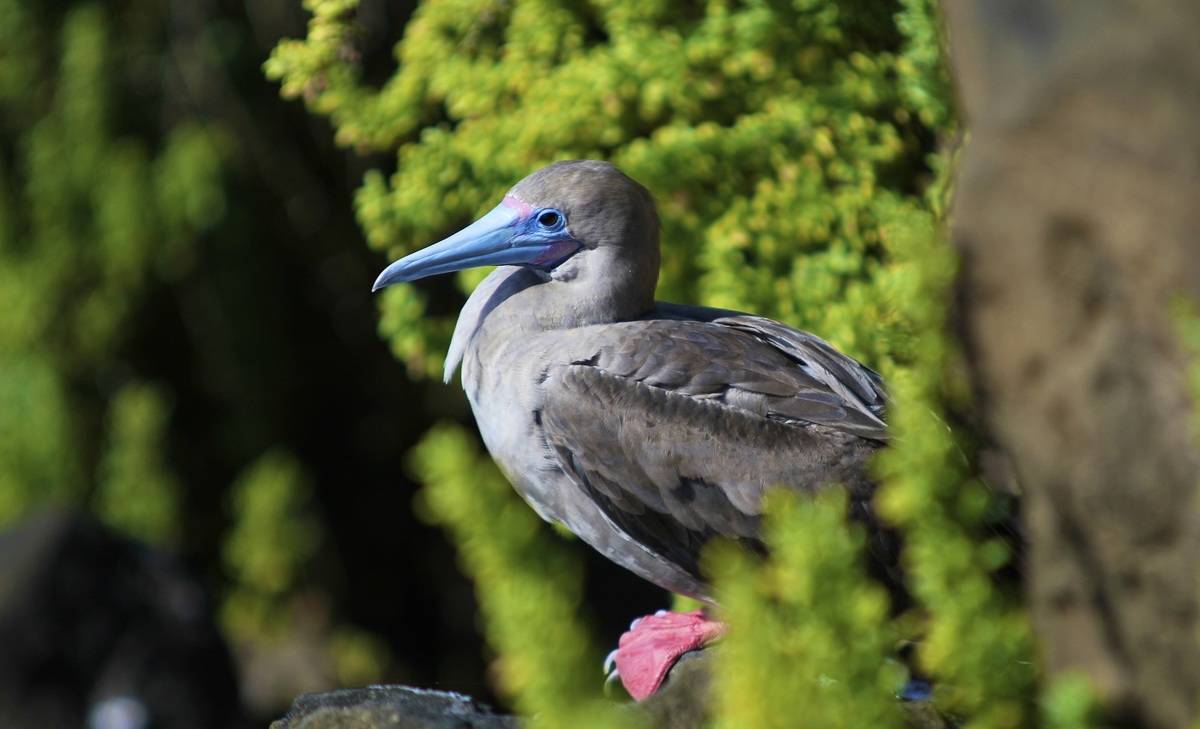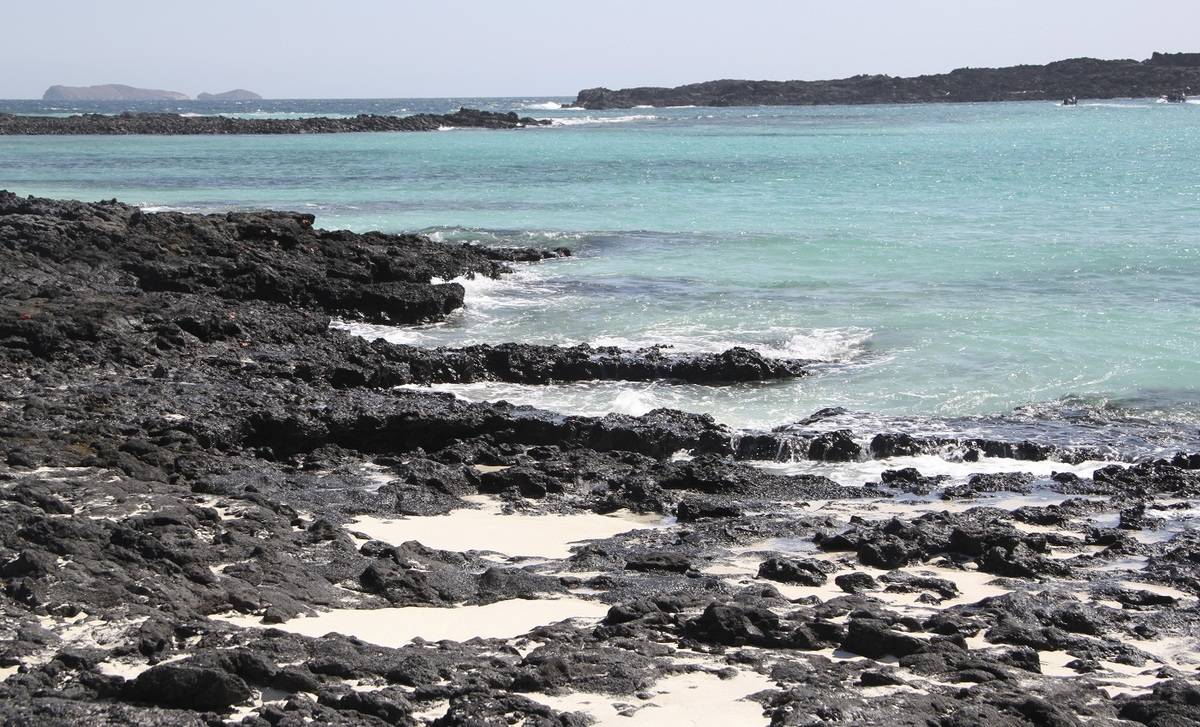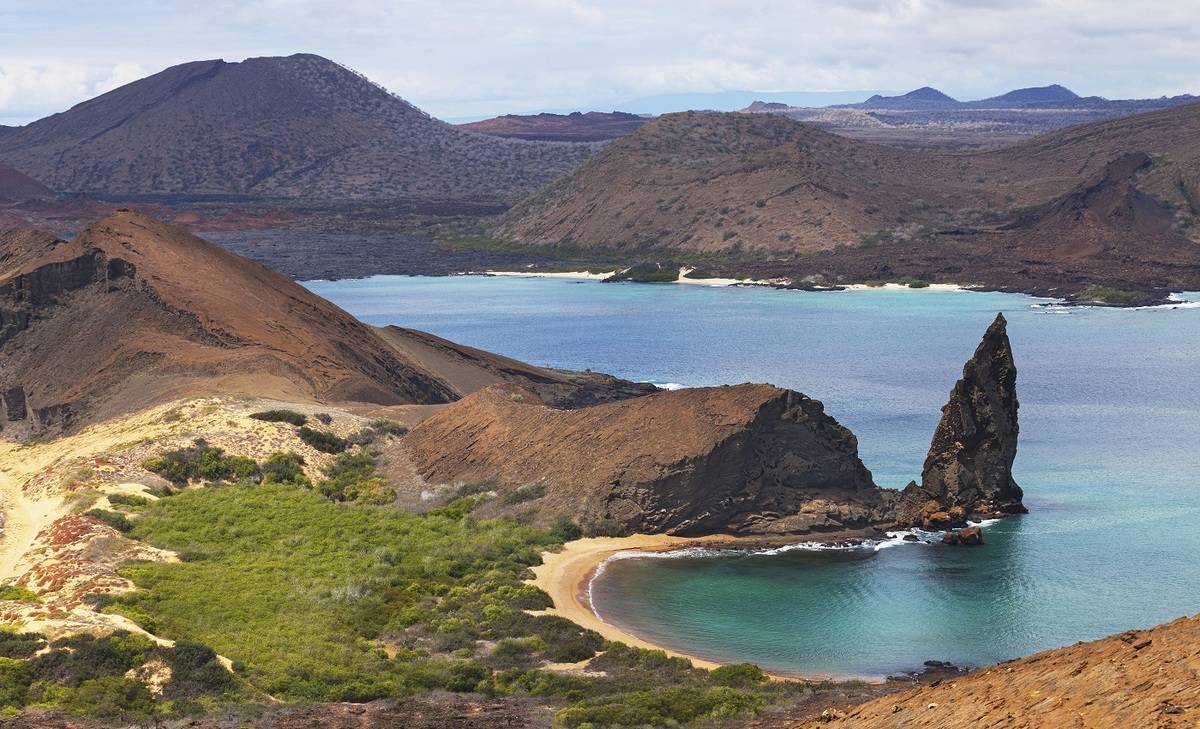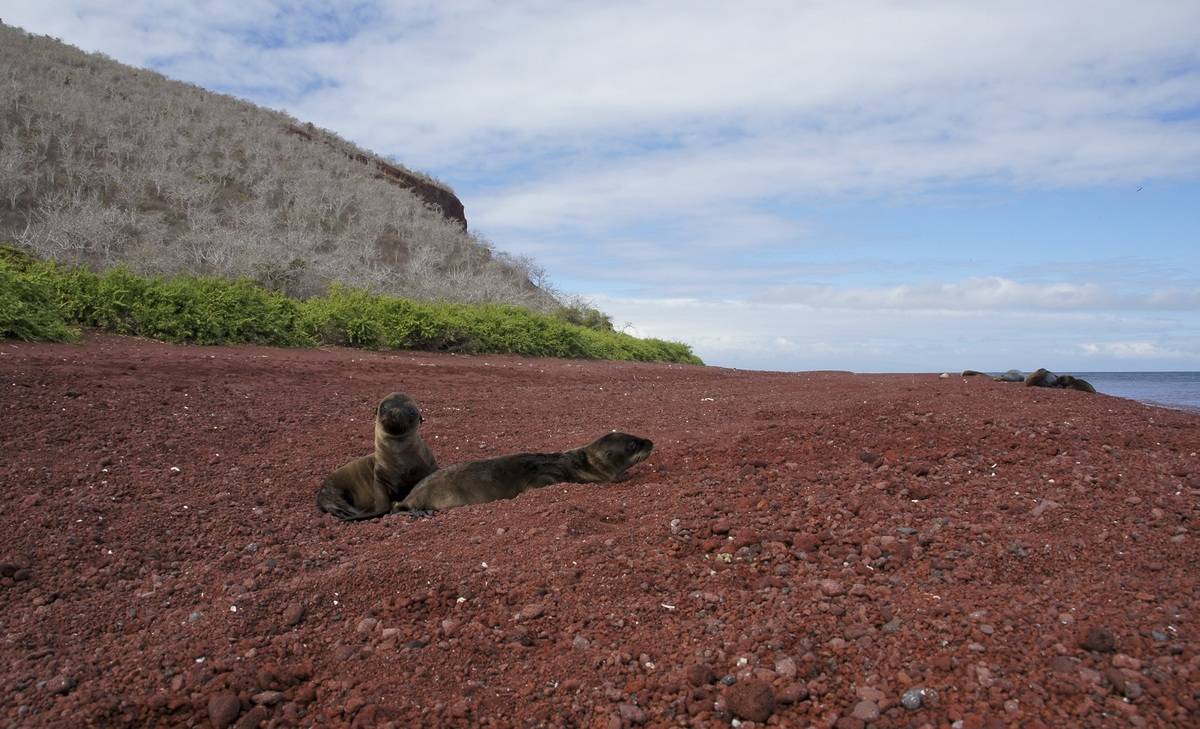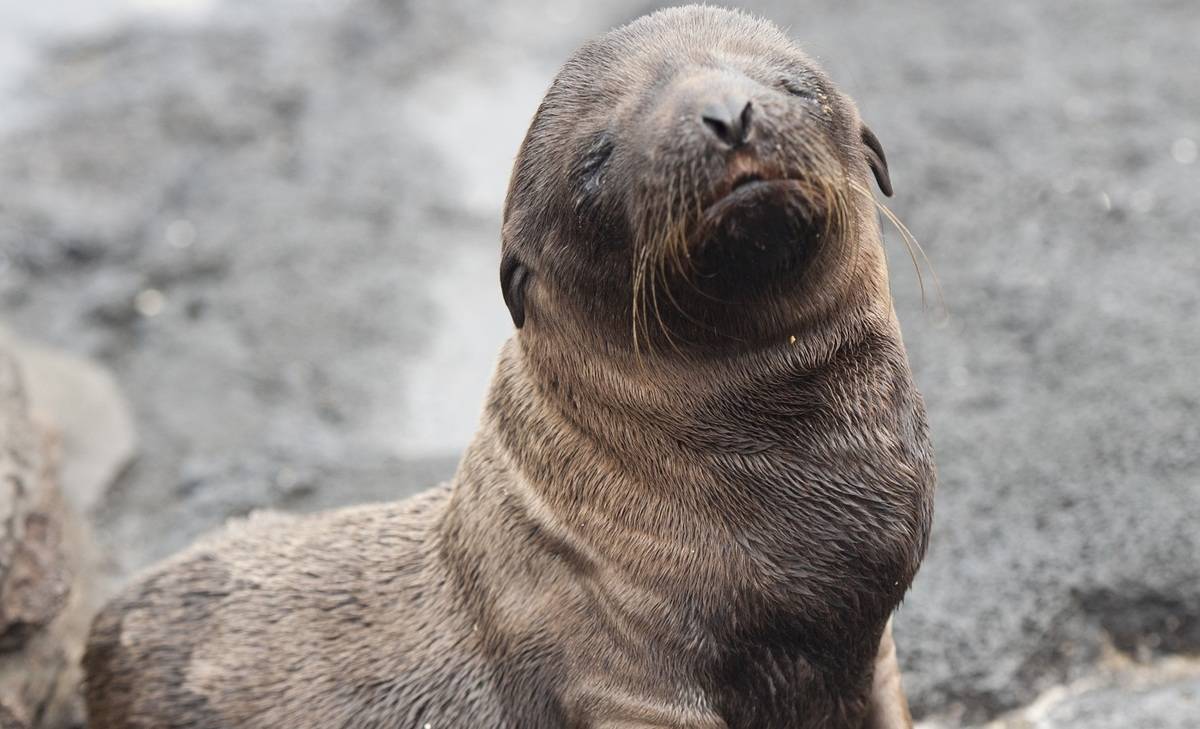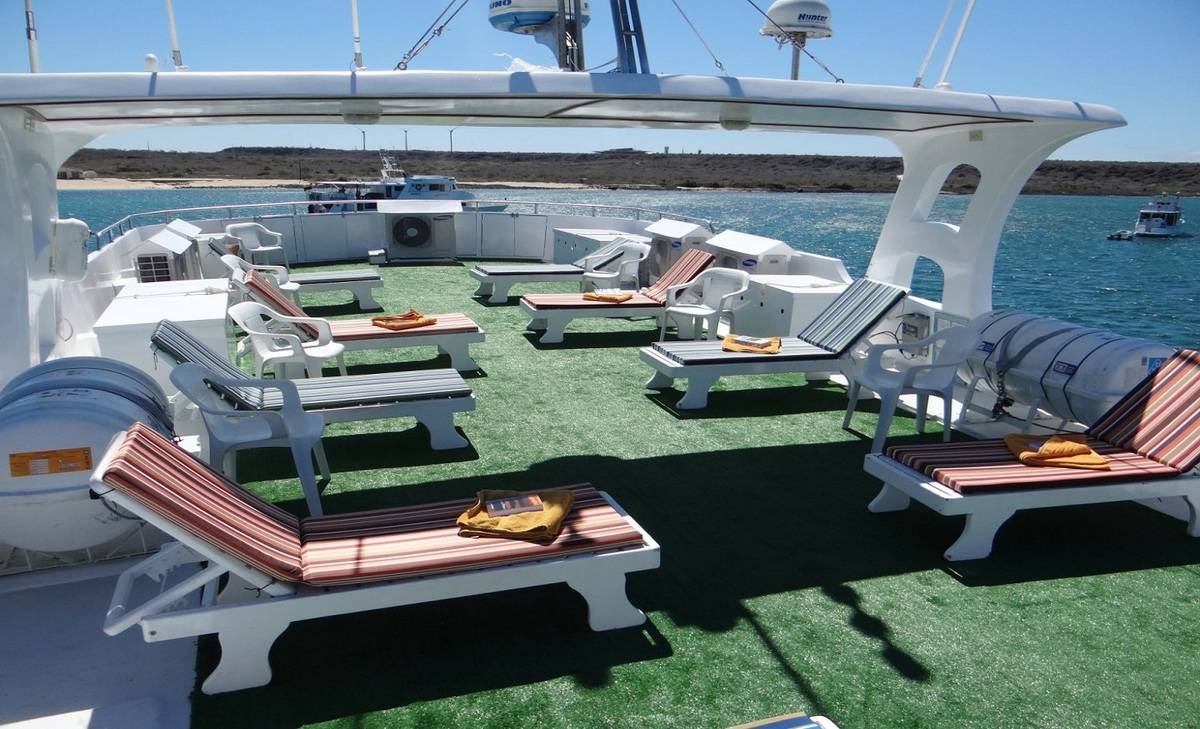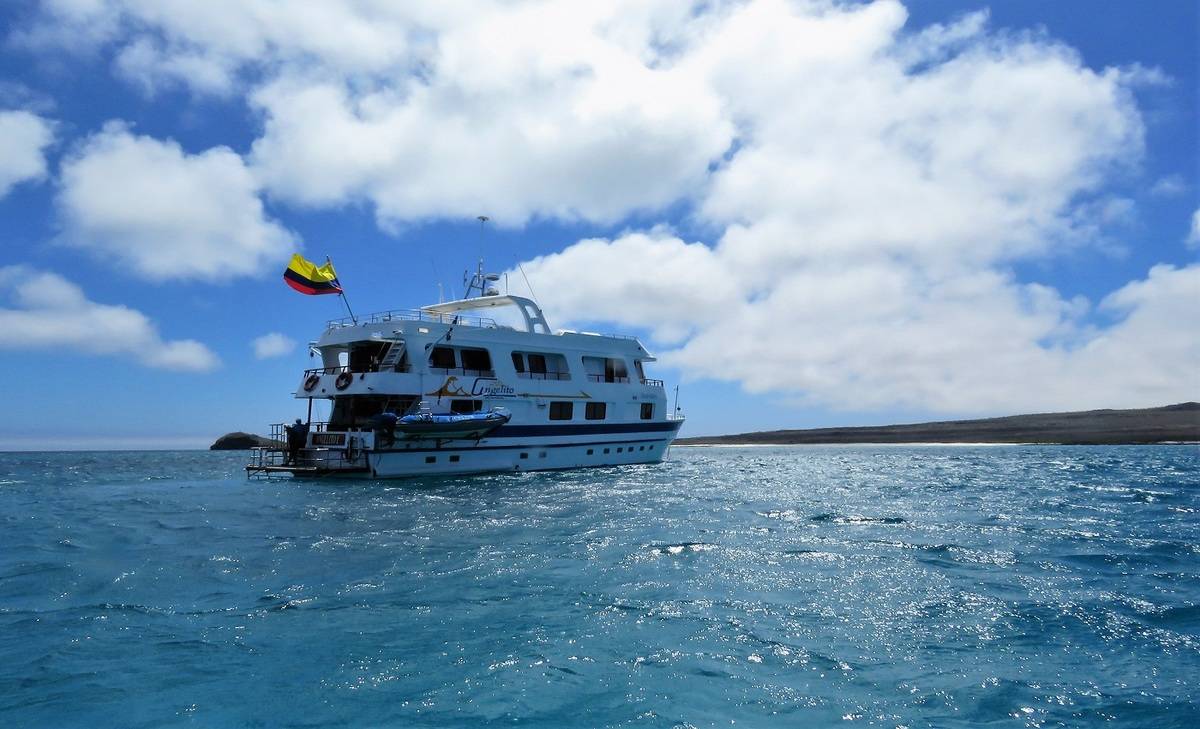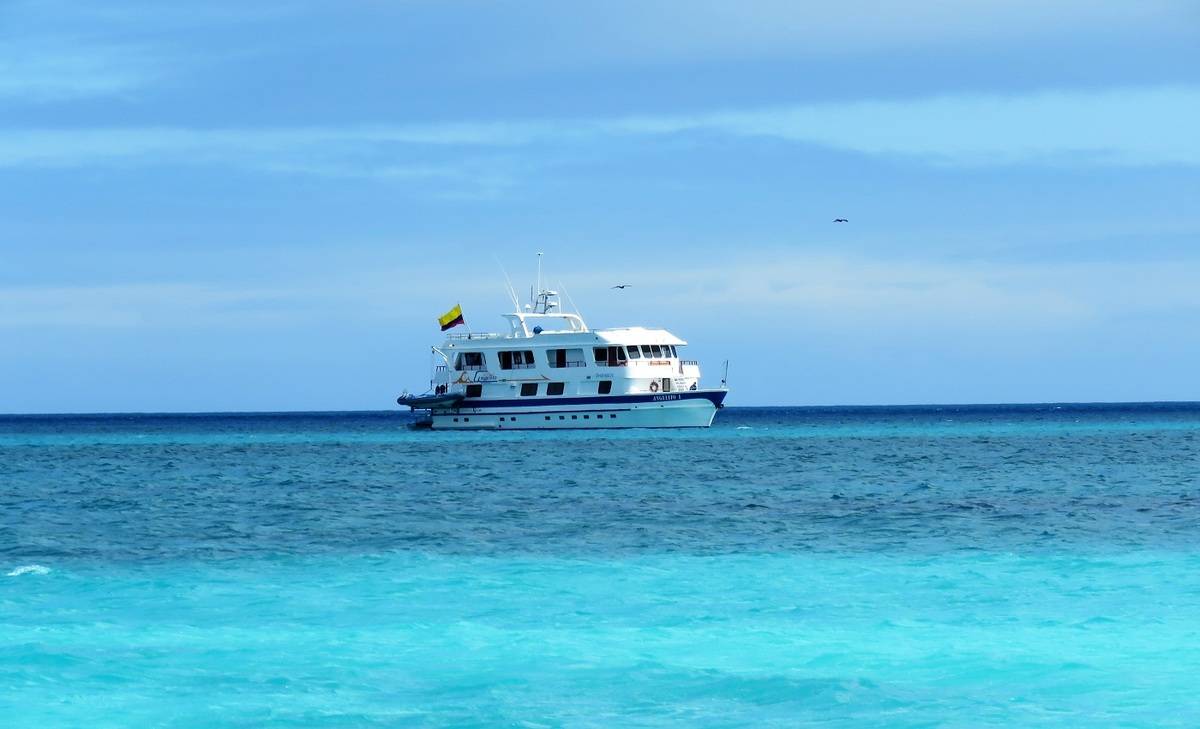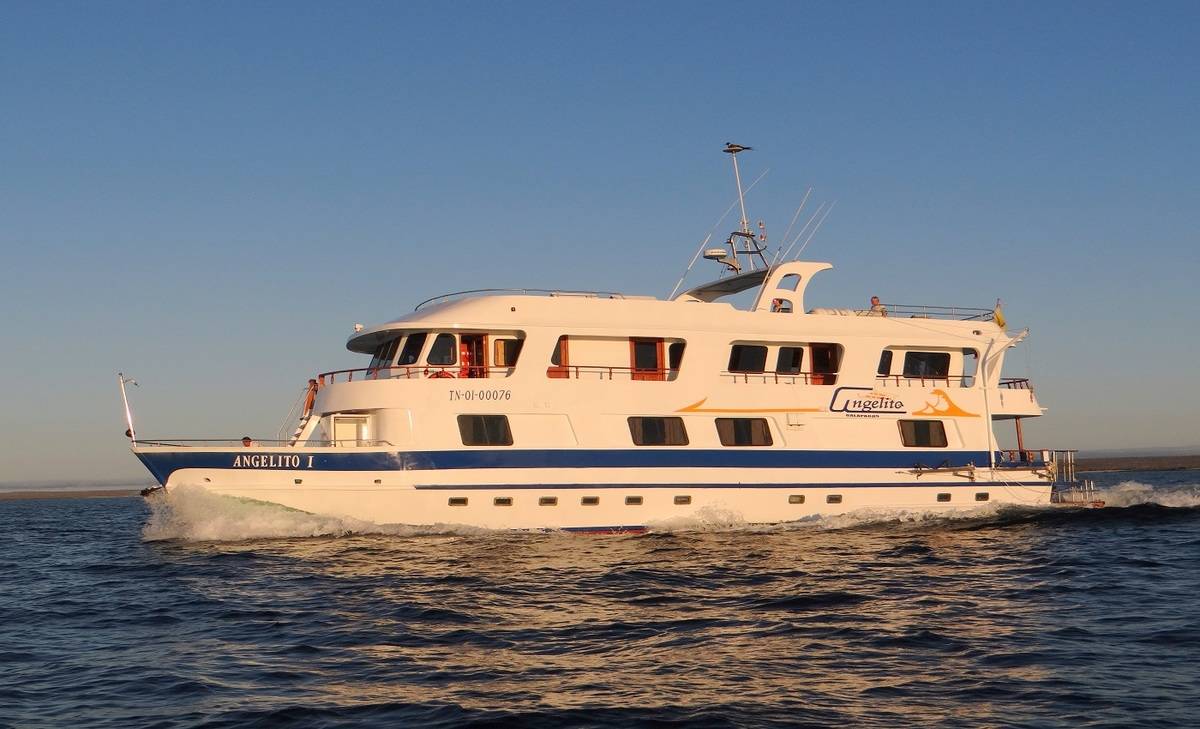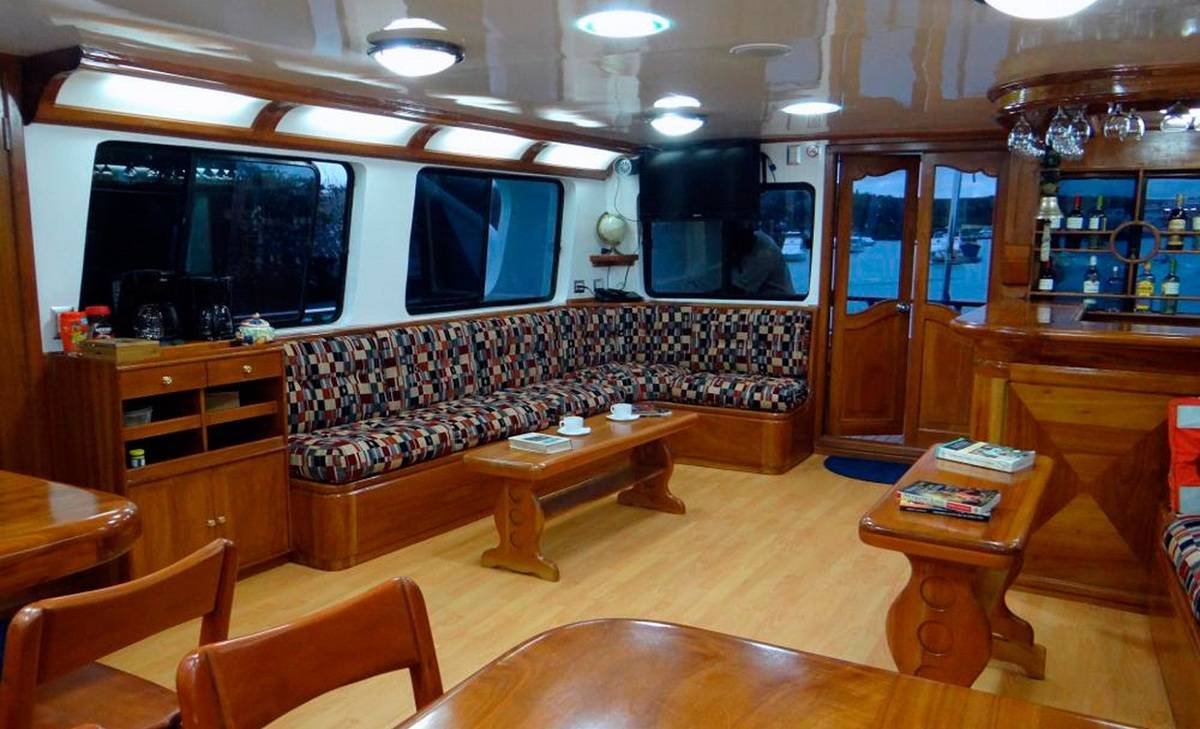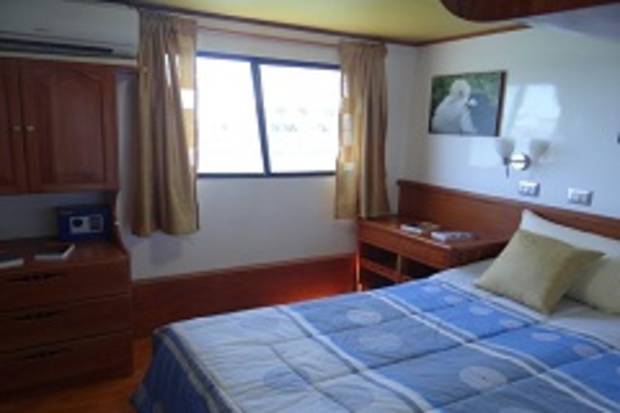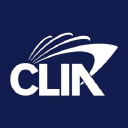Northern Galapagos Islands
5 Days - Angelito
The Angelito offers an exceptional value and personalised Galapagos experience. On this 5 day voyage you will journey through the central and northern islands including incredible Genovesa which is home to the Red-footed Booby. Expect fabulous scenery and close-up encounters with the unique wildlife of the Galapagos Islands.

Home » Angelito: Northern Galapagos Islands
Itinerary Highlights
- Air conditioning in all cabins, social areas and kitchen
- Quality naturalist guide
- Plenty of snorkelling opportunities (equipment included)
- Visit spectacular Pinnacle Rock
- Fantastic wildlife spotting including the chance to see Galapagos penguins
Itinerary in Brief
- Day 1: Baltra - North Seymour
- Day 2: Chinese Hat – Bartolome
- Day 3: Genovesa: Darwin Bay - Prince Phillips Steps
- Day 4: Puerto Egas – Rabida
- Day 5: Darwin Station – Baltra
(Itinerary A Route: Sunday - Thursday)
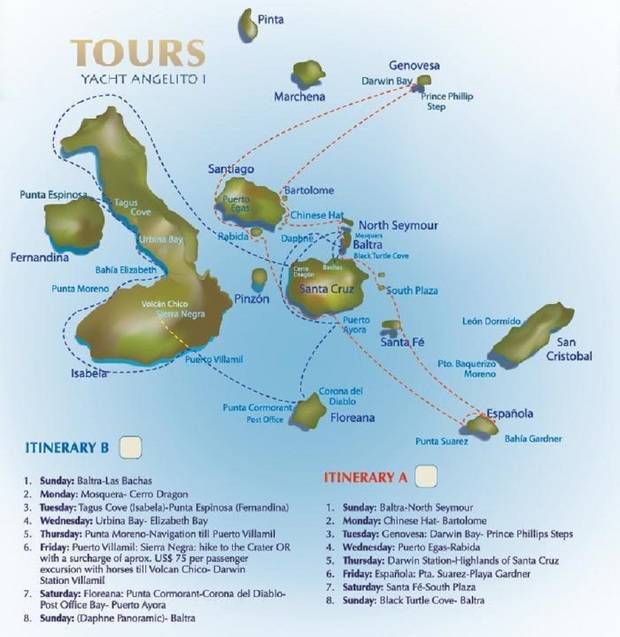
Day 1: Baltra - North Seymour
Today you will take a flight from mainland Ecuador to the island Baltra in the Galapagos Islands. The flight from Guayaquil to Galapagos takes about 90 minutes. Arriving on the airport, the visitors have first to pay the entrance fee of US$ 100 for the National park.
It’s a flat uplifted island in the "rain shadow" of the island Santa Cruz and for this reason, with dry vegetation of the Arid Zone. Loop trail. The dry landing on a landing peer is often somewhat difficult depending of the swell. The arrival on the rocky coast is full of surprises with the sea lions, swallow-tailed gulls, sally lightfoot crabs and marine iguanas. The trail leads through the nesting area of colonies of blue-footed boobies and frigate bird.
Day 2: Chinese Hat – Bartolome
The shape of the island looks like a Chinese hat and the island is very attractive because of the landscape. The wet landing is on a small white coral beach with sea lions. The easy and short trail leads along the coast with very fragile lava. There are a lot of small lava tubes and little but very attractive vegetation. Pillow lava can be found on the turning point of the trail.
The summit trail leads to the top of Bartolomé on a wooden foot-bridge and stairs to protect the fragile landscape. The view from the top across Bartolomé, Santiago with Sullivan Bay and the surrounding islands is wonderful. All the secondary cones, lava flows and lava tubes mimick a moon landscape.
In the late afternoon we go with the dinghy along the coast to look out for the Galapagos penguins. The penguin lives and nests in the lava tubes of the rocky coast, along where he is also fishing.
Day 3: Genovesa: Darwin Bay - Prince Phillips Steps
Wet landing on a small white beach made of coral sand. The trail follows the shore vegetation of red mangrove and salt bush. The special prickly pear cactus grows on Genovesa often like a hanging cactus with only soft hairy spines. Under the shore vegetation are nesting the swallow-tailed gulls and in the bushes and trees there are the nests of the red-footed boobies and great frigate birds. A few Nazca boobies are nesting on the ground. The trail leads along small tide pools up to the cliff with a spectacular view over the caldera. By low tide there are thousands of Galapagos fiddler crabs in the sandy ground.
The Prince Phillip's Steps offer the only possibility to climb the steep basaltic cliff. The following easy trail leads first through a small nesting colony of masked boobies and crosses a low and dense forest of palo santo trees where the red-footed boobies have their nests. Arriving on the edge of the island there are thousands of the small petrels nesting in the crevices and tubes of the fragile lava. They are the favourite food of the short-eared owls. On both sides of the trail there is a big Nazca booby nesting colony.
Day 4: Puerto Egas – Rabida
Landmark of Puerto Egas are the tuff formations of the cliffs with the relief structures. The wet landing is on a black beach. The walk with the intertidal life shows during the always changing tide levels an interesting special fauna. Often we can observe lava herons fishing in the isolated tidal pools. On the whole walk we can see Galapagos sea lions, sally lightfoot crabs and marine iguanas. Depending of the season, there are also a lot of migrant shore birds, living on these rich coasts during wintertime. On the turning point of the trail is the start of a Galapagos fur seal colony. The Galapagos fur seal has found an ideal living space in the crevices and caves of the rocky lava coast.
Rabida looks red with the lava containing a lot of ferric oxide in the lava. Very special is the red sand of the beach with the saltbush vegetation and the silvery palo santo trees on the slopes. The batch of Rabida had before the last "El Niño) one of the biggest Galapagos sea lion colony. This colony has to recuperate again from the small remainder population. There is a small lagoon behind the zone of saltbush vegetation with (depending of the season) flamingos and white-cheeked pintail ducks.
Day 5: Darwin Station – Baltra
The visit to the Charles Darwin Research Station gives the opportunity to get to known the scientific work taking place in the National Park. Especially the raising programs for the different subspecies of the giant tortoises are very well documented.
It is also a good opportunity to observe the Galapagos tortoises up-close; the symbol of Galapagos. In the Van Straiten Exhibition Hall, there is great documentation about the Galapagos Islands with photos and diagrams. The vegetation on this hike is exuberant green, and a lot of Darwin's finches are easy to spot.
At the end of the cruise, the passengers leave the Angelito again in the harbor of Baltra and your guide takes care of everything until you fly back to the continent.
Cabin Details
Standard Cabin
Double bed or 2 single beds, private bathroom, window, ocean view, A/C, safe, hairdryer.
Angelito Deckplan
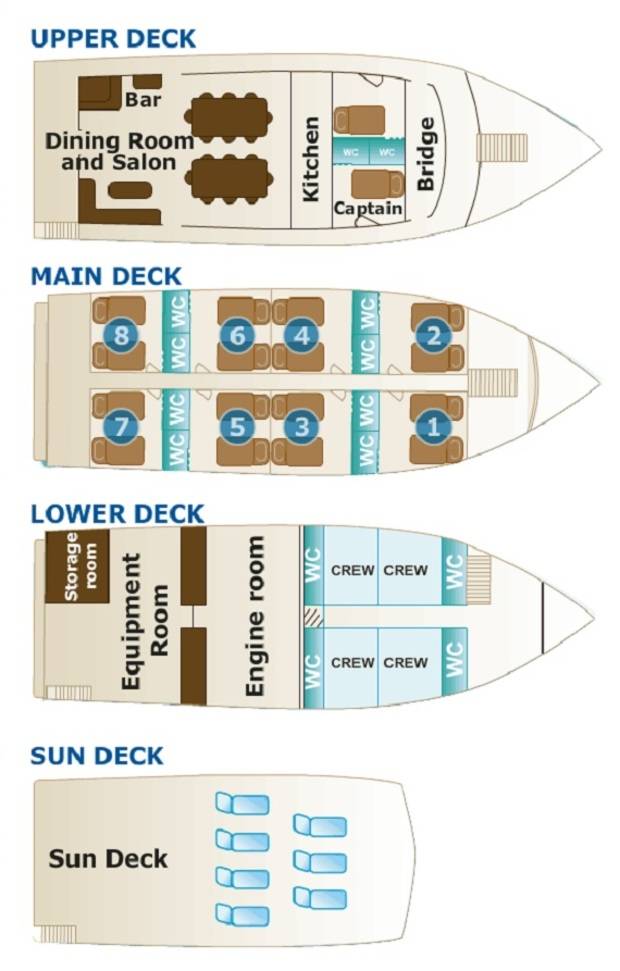
Specifications
- Construction - Puerto Ayora, Galapagos in 1992
- Refurbishment - Guayaquil, Ecuador in 2013
- Category - Tourist Superior
- Gross Tonnage - 152
- Capacity - 16 passengers in 8 double cabins
- Length - 22.3 meters (70 feet)
- Beam - 6.6 meters (22 feet)
- Speed - 12 knots
- Electricity - 110 Volts in the cabins and bathroom and 220 Volt sockets available in Dining area.
- Engines - 2 CUMMINS ( Marine Diesel), 405 HP each and 2100 RPM (new 2013)
- Generators - 2 CUMMINS_CPG (Diesel) with capacity of 65KW/60HZ each (new 2013)
- PureVent (= Fuel cleaner): PureVent is a radical new approach to cleaning the gas vented from engine crankcases by using centrifugal separation technology to remove oil mist and other particles, and help protect the environment.
- Navigation - 2 GPS, Magnetic Compass, radar with range of 36 miles, echo-sounders
- Desalinization machine with capacity for 65 gallons of fresh water per hour
- Individual Air condition in all cabins, social areas, kitchen, and bridge and engine room: Compressors with the newest technology certified for use in protected areas.
- HUNTER - Satellite GPS Monitoring, with digital maps and a real time monitoring program
- Control of all strategic points of the boat like engine rooms with TV cameras and monitor on the bridge
- Safety Classification - SOLAS 74 (safety of life at sea) ISM an ISPS - MARPOL
- Smoke Detectors in each cabin and each area of the Yacht
- Life Jackets - 2 life jackets SOLAS in each cabin and additional several in different strategic points of the Yacht ,
- Life Rafts - in total 2 - one for 16 persons and one for 12 persons
- Zodiacs - 2 with capacity for 10 passenger each for transportation from the boat to the shore
- Outboard motors for zodiacs: Yamaha ecological with 25 hp each and with protectors over the propellers
- Decks - 4 (Sun deck, Upper Deck, Main Deck, Lower Deck
- 8 Crew - captain, first mate (steersman), multilingual naturalist guide, machinist, 2 sailors, cook and auxiliary cook
Whats included?
- On-board accommodation
- All meals during your cruise
- Activities/shore excursions as specified
- Bilingual naturalist guides
- Snorkelling equipment
- Transfers
What’s not included?
- International and internal airfares
- Arrival/departure taxes or reciprocity fees, visa fees where applicable
- Travel insurance
- Fuel surcharges
- Galapagos national park fee US$100
- Transit control card US$20
- Wetsuit rental
- Gratuities
- Any items not mentioned as included

